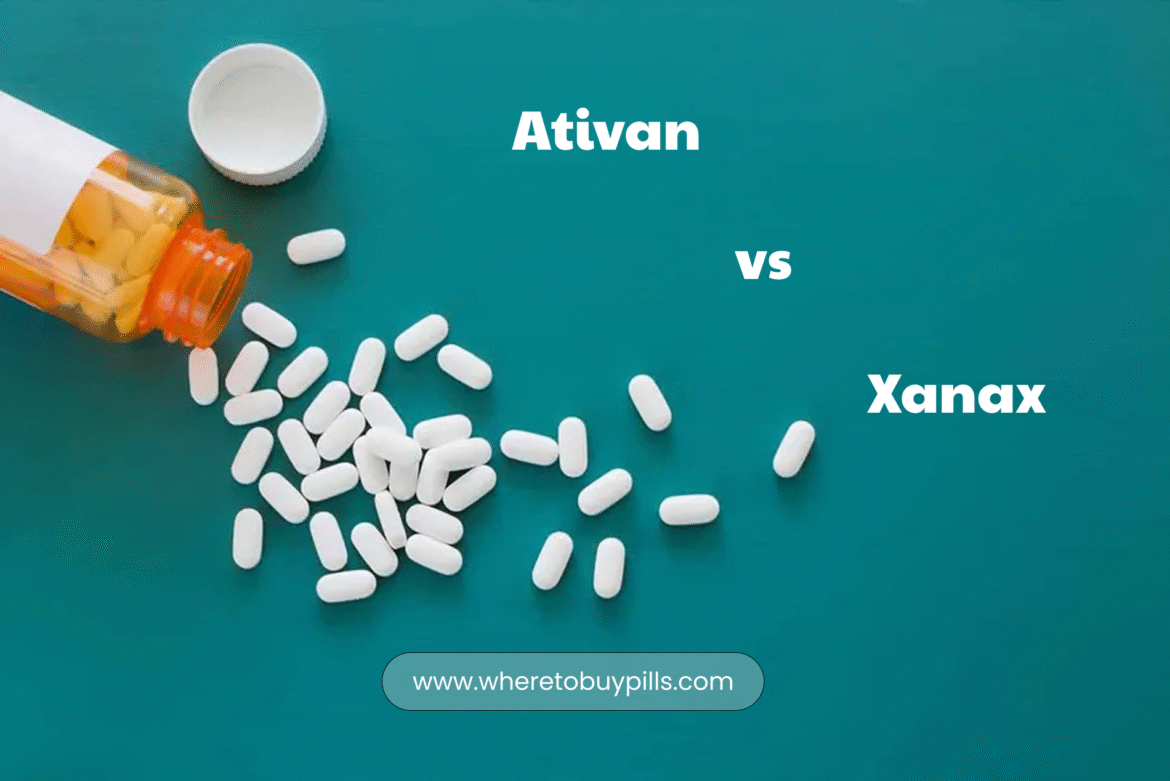Ativan vs Xanax – Differences, Uses & Side Effects Buy Xanax Online
When it comes to treating anxiety and panic disorders, two of the most frequently prescribed medications are Ativan (lorazepam) and Xanax (alprazolam). Both belong to the benzodiazepine class of drugs and work by calming the central nervous system.
While they share many similarities, Ativan and Xanax differ in how quickly they act, how long they last, and how they affect dependence and withdrawal.
Let’s explore their key differences, similarities, side effects, and safety considerations. Ativan vs Xanax.
What Are Ativan and Xanax?
Ativan (lorazepam) and Xanax (alprazolam) are both prescription sedatives used to treat anxiety disorders, panic attacks, and sometimes insomnia or seizures (off-label).
They work by enhancing GABA (gamma-aminobutyric acid) — a brain chemical that reduces nerve activity, creating a sense of calm and relaxation.
However, subtle pharmacological differences between Ativan and Xanax can make one more suitable than the other for specific patients. Ativan vs Xanax.
Ativan vs Xanax: Quick Comparison Table
| Feature | Ativan (Lorazepam) | Xanax (Alprazolam) |
|---|---|---|
| Drug Class | Benzodiazepine | Benzodiazepine |
| Onset of Action | 20–60 minutes | 15–30 minutes |
| Duration of Action | 6–8 hours | 4–6 hours |
| Half-Life | ~12 hours | ~11 hours |
| Primary Use | General anxiety, insomnia | Panic attacks, anxiety |
| Addiction Risk | Moderate | High |
| Withdrawal Severity | Moderate | Severe (shorter-acting) |
Key Differences Between Ativan and Xanax
1. Speed of Onset
Xanax acts faster — typically within 15 to 30 minutes, making it ideal for acute anxiety or panic attacks.
Ativan, while slightly slower (20–60 minutes), provides steadier, longer-lasting relief.
2. Duration of Effect
Ativan remains active in your body for 6–8 hours, while Xanax’s effects fade after 4–6 hours.
This means Ativan may be taken less frequently and can cause fewer rebound anxiety symptoms between doses.
3. Risk of Dependence
All benzodiazepines carry addiction risks, but Xanax tends to cause dependence faster due to its rapid onset and short half-life.
Ativan may be safer for short-term use under supervision but can still lead to withdrawal if misused.
4. Withdrawal Symptoms
Because Xanax leaves the body faster, its withdrawal can be more intense — causing rebound anxiety, insomnia, or tremors.
Ativan’s longer half-life allows for a smoother tapering process, making discontinuation slightly easier.
5. Sedation and Drowsiness
Both drugs cause sedation, but Ativan’s effects are usually milder and longer-lasting.
Xanax’s sedation tends to peak quickly, which can interfere with activities requiring focus. Ativan vs Xanax.
Ativan vs Xanax: Effectiveness for Anxiety
Both medications are equally effective for short-term relief from anxiety and panic symptoms.
However:
-
Xanax works better for rapid panic attacks due to its quick onset.
-
Ativan may be more suitable for generalized anxiety or sleep-related tension since it lasts longer.
Doctors often prescribe Ativan for patients who need steady, all-day relief and Xanax for those experiencing sudden, intense anxiety episodes.
Common Side Effects
Both Ativan and Xanax share similar side effects, though intensity may vary.
Common side effects include:
-
Drowsiness or fatigue
-
Dizziness
-
Memory issues
-
Slurred speech
-
Confusion or disorientation
-
Blurred vision
-
Dry mouth
Serious side effects:
-
Dependence or withdrawal symptoms
-
Depressed breathing (especially with alcohol or opioids)
-
Mood changes or suicidal thoughts (rare)
Ativan vs Xanax: Which Lasts Longer?
Ativan has a slightly longer half-life and remains active longer in the body, making it better for generalized anxiety and insomnia.
Xanax, though shorter-acting, provides fast relief — making it effective for panic attacks.
If you need continuous symptom control, Ativan may offer smoother coverage throughout the day.
Dependence and Withdrawal
Both medications can cause dependence and withdrawal, especially with prolonged or high-dose use.
Withdrawal symptoms may include:
-
Anxiety or panic attacks
-
Restlessness
-
Insomnia
-
Muscle pain
-
Tremors
-
Seizures (in severe cases)
To prevent withdrawal, doctors recommend gradual tapering rather than abrupt discontinuation.
Which Is Safer?
Both drugs are safe when used short-term and under supervision, but there are differences in safety:
-
Ativan is often preferred for elderly patients or those with liver problems because it’s metabolized differently and less likely to accumulate.
-
Xanax is more likely to cause addiction and rebound anxiety with long-term use.
For chronic anxiety, doctors often prefer non-benzodiazepine options like SSRIs or therapy.
Ativan vs Xanax: Final Verdict
| Category | Best Choice |
|---|---|
| Fast relief of panic attacks | Xanax |
| Long-lasting anxiety control | Ativan |
| Lower addiction risk | Ativan |
| Easier withdrawal | Ativan |
| Short-term intense anxiety | Xanax |
In short:
-
Choose Xanax for short, situational panic episodes (under doctor supervision).
-
Choose Ativan for longer-lasting anxiety management or if you’re sensitive to strong sedative effects.
Always follow your doctor’s prescription and never mix benzodiazepines with alcohol or opioids.
FAQ: Ativan vs Xanax
1. Which works faster, Ativan or Xanax?
Xanax works faster, taking effect within 15–30 minutes, while Ativan typically starts working in 30–60 minutes.
2. Which lasts longer in the body?
Ativan lasts longer (6–8 hours) compared to Xanax (4–6 hours), providing steadier anxiety relief.
3. Which has a higher addiction risk?
Xanax has a higher addiction risk due to its shorter half-life and rapid onset.
4. Can I switch from Xanax to Ativan?
Yes, but only under medical guidance. Dosage and tapering schedules must be carefully managed to avoid withdrawal symptoms.
5. Are Ativan and Xanax safe for long-term use?
No. Both are intended for short-term use only due to dependence and withdrawal risks.


